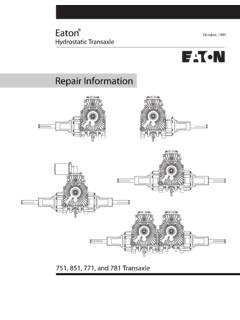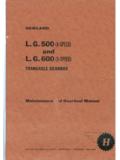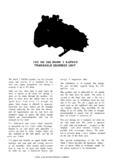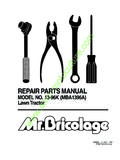Transcription of The Difference between GL-4 and GL-5 Gear Oils by Richard ...
1 The Difference between GL-4 and GL-5 gear oils 1 of 12 The Difference between GL-4 and GL-5 Gear Oils by Richard Widman Revision 6-2017 The original target audience for this paper was my group of friends in the Corvair world, but it applies to all cars and is particularly important for all classic cars. There is a lot of confusion about gear oils and the API classifications. In this paper I will try to differentiate the two oils and clear up the mysteries that are flying all over the internet. It is extremely common, or normal, for all GL-5 oils to claim they cover the API GL-4 requirements for gear oils. This is a true statement. Does that make them satisfactory for synchromesh or synchronized transmissions?
2 NO! They meet the GEAR OIL specifications, not transmission oil specifications. The API GL-4 and GL-5 categories do not mention or have anything to do with transmission synchronizers. History: The gear oils of a few decades ago had lead additives that were effective at wear reduction, but not very good for the environment. A long time ago they began to be replaced by gear oils with a phosphorous additive (in itself a decent anti-wear additive) with active sulfur to grip hold of the gears and create a very solid sacrificial layer of material that could be worn off, thereby protecting the gear surface. Eventually it was discovered that the active sulfur was causing corrosion of brass and other soft metals used in differentials and transmissions. Somewhere around 25 years ago a deactivated or buffered sulfur was developed that would react with the phosphorous to create the protective/sacrificial layer in the conditions created in the gear boxes (temperature and pressure) without being corrosive to the brass, copper, etc.
3 This additive system is used in most gear oils today. The problems arise when we try or need to use the same product in the transmission that we use in the differential. Many people have called oil companies and been told by the Techs that answer their questions that their oils have buffered sulfur and therefore are not corrosive to yellow metals, so their GL-5 oils can be used with brass components. While that answer is totally correct, it does not address the question asked: Can I use your GL-5 in my synchromesh transmission? Let s take a look at the API GL-5 rating. It is a rating for EP (Extreme Pressure) protection. The higher the EP protection, the higher the GL category. In the mid 60's, Ford needed better protection in their pickup trucks and GM developed the front wheel drive Oldsmobile Toronado that had a differential with a very high angle of contact for power transmission to the wheels so a higher category was developed (later to be called GL-6) to offer the protection needed.
4 This level of protection can still be claimed, but can no longer be tested since the Toronado rig used to test it is no longer available. (Note: The 1966 and 1967 Toronados had sun gears between the axle shafts instead of spyder gears and a very high offset, while suffering from the high temperatures of the engine compartment and very high pressures.) This is why you will frequently see GL-6 listed as obsolete . The test is obsolete, not the car or its needs. Many other high performance cars continue to spec this level of EP performance. In normal operation, the sulfur/phosphorous additive forms a black sacrificial coating on the gears and anything it touches with a little pressure and temperature. As the gears turn, instead of wearing, the sacrificial coating of additives is peeled off or worn off.
5 This is normal and acceptable in all steel gears. But when one or more of the surfaces is brass or another soft metal, the sacrificial coating is stronger than the base metal, and instead of just peeling off, it takes with it a few microns of brass that it is bound to. The Difference between GL-4 and GL-5 gear oils 2 of 12 A traditional GL-4 gear oil of any given viscosity has about of the level of sulfur/phosphorous additive that would be in the GL-5 product, so the bond is not as strong, and therefore can be peeled off without peeling a layer of brass (or less brass). This means that the GL-4 product provides a little less extreme pressure protection, so in the differential of a high-powered car, it would not be the ideal product in the differential.
6 To understand this need we should be aware of the fact that the differential is where the final torque is applied to the wheels (in most applications). But in the transmission, we should consider two factors: Due to the fact that the differential applies the final torque, normally we do not need the full EP protection in the transmission where less torque (about 30%) is applied. We need to be able to break the EP protection to stop the spinning of the gears long enough to mesh them or synchronize them. When we use a GL-5 product in a transmission that requires GL-4, we normally find 2 to 4 times as much copper in the used oil as we would with a GL-4 product (with used oil analysis). Eventually the synchronizers wear to the point that they no longer make contact with the other half of the cone, bottoming out before stopping the opposing gear.
7 (Refer to the picture below.) GL-3 It should be noted that while GL-3 is frequently considered obsolete since it has less protection than the GL-4, some transmission manufacturers today specify GL-3 (Chrysler and Mitsubishi among them). There are many formulations of GL-3 oils in the market, some with sulfur/phosphorous additive and some with zinc/phosphorous. Almost any diesel motor oil classifies as a GL-3 or GL-4 in gear protection. Synchromesh transmission oils General Motors, Honda and others have developed oils that combine the best shift characteristics with their transmission components for reduced wear. These products in general could classify as GL-4 oils if they wanted to, but actually when we analyze their components they are very similar to 5W-30 diesel motor oils, with a few friction modifiers added.
8 The viscosity is closer to an ATF. They are way too thin for a Corvair transmission or any other where a SAE 80W-90 or 75W-90 is recommended. Modern transmission oils I am getting questions about the application of traditional GL-4 or GL-5 oils in modern cars or the use of modern transmission oils in classic cars, so let s look into them. A lot of study has gone into the development of oils that are more slippery, more protective, and more efficient. The current emphasis on fuel economy has driven many new transmission designs and oils to match them. The economy gains have come with gear and machining design (smaller synchronizers with double sided contact surfaces fused onto the ring) in an assembly that not only permits, but requires, thinner oils.
9 They also cannot tolerate sulfur/phosphorous additives in the oil, depending on friction modifiers and new compounds to achieve GL-4 or better performance. This can become confusing, as few lubricant manufacturers state their ingredients. All you see are claims for performance or recommendations for their own brand. In most cases these new formulations are much better for the transmission and its efficiency. For the most part these are SAE 75W-80 and 75W-85 oils. Way too thin for most classic cars, but necessary for modern cars. The additive package uses magnesium or calcium sulfonate compounds and often synthetic base oil, and will give you better EP protection than a GL-4 sulfur/phosphorous oil. The Difference between GL-4 and GL-5 gear oils 3 of 12 Many of these claim GL-4+ performance and pass most of the old GL-5 and SAE J2360 extreme pressure tests, but additionally pass manufacturers tests for synchronization.
10 The problems of where to apply them lie with the auto manufacturers, where, for example, Toyota specifies in their owner s manual, their SAE 75W without defining the rest of it. Oil sales people will sell you 75W-90, but what Toyota is really asking for is 75W-85 without sulfur/phosphorous. From the comments I receive, a standard SAE 75W-90 GL-4 does cause hard shifting and grinding in these Toyotas in 70 F weather. Nissan has the same problem with 75W-90 oil, but their manual clearly states 75W-80 for 6 speed transmissions and 75W-85 for 5 speed transmissions. It does not specify "non sulfur/phosphorous" oil, instead referring to "Genuine Nissan Oil" (which does not contain those additives). VW calls for 75W oil that meets their spec.





